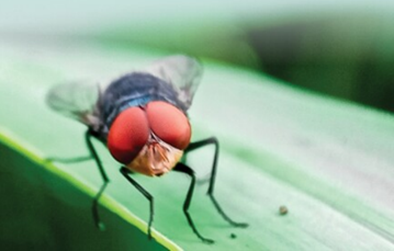

Dr. Lew Strickland
Associate Professor and Extension Livestock Veterinarian
Department of Animal Science
P: 865-974-3150
I often receive questions from producers concerning ‘what is the next new thing we need to be watching for?’ Well, since you asked Dr. Samantha Beaty, our State Veterinarian has alerted us of a concern that we all need to be on the lookout for. The U.S. cattle industry has not faced the threat of New World screwworm (NWS) for over 60 years. However, the NWS fly, which is about the size of a common housefly, has migrated across Central America from Panama and entered southern Mexico.
Live cattle trade to the U.S. from Mexico was halted on Nov. 22, 2024, after a cow in the southern Mexican state of Chiapas was found to have NWS myiasis. However, cattle and bison imports have resumed in 2025 with established NWS mitigation protocols, the holding of Mexican cattle for preventive treatments, and multiple inspections of Mexican cattle on both sides of the border.
At the time of this article, NWS has not been found in the U.S., but this harmful pest can travel on humans, vehicles, pets, livestock and even on wildlife species — all of which increase the likelihood it could eventually enter our country. Now in Mexico, it is easy for screwworms to travel north and appear on our southern border.
What is the concern with NWS?
NWS infestation results in a condition called myiasis. Myiasis is NWS larvae or maggots that feed on the living tissues of all warm-blooded animals, including humans. Adult female flies lay their eggs, often as many as 200 to 300 eggs at a time, at the edges of wounds on animals or at the mucous membranes of body orifices. Within 12 to 24 hours the eggs will hatch, and larvae emerge to feed on living flesh by burrowing into tissue, tearing at the tissue with their hook-like mouthparts, like a screw being driven into wood. Fig 1. Unfortunately, these flesh-eating flies are now on the march north.
Recently, screwworms were discovered in southern Mexico, which raised concerns at the National Cattlemen’s Beef Association (NCBA).
Fig 1. Photo: USDA-APHIS and CDC.

The larvae can be difficult to detect for the first 24 to 48 hours, but as larvae feed on tissue, the wound enlarges and drains a serosanguineous fluid. There is severe inflammation and secondary infection as well as the stench of necrotic tissue.
Screwworm larvae pass through three stages, and they will reach maturity about five to seven days after the eggs hatch. At maturity, the larvae stop feeding and fall to the ground where they burrow and pupate to become adult flies. Adult flies live for two to three weeks in the field. Females mate only once in their lifetime.
Diagnosis
Although we haven’t confirmed any New World screwworms in the United States, we need you to be on high alert. New World screwworms have orange eyes, a metallic blue or green body, and three dark stripes across their backs. If you see any suspicious flies, please alert your local veterinarian, extension agent, or contact USDA-APHIS Veterinary Services.
Please also pay close attention to your cattle and watch for any open wounds or sores. If cattle exhibit irritated behavior, head shaking, you notice the smell of decaying flesh, or spot maggots in a wound, seek treatment from a veterinarian immediately. Proper wound treatment and prevention is the best way to protect your farm or ranch from a screwworm infestation. NCBA is also sharing the latest updates through their website. I encourage you to visit www.ncba.org/NWS for all the latest information on how to protect your operation.
NWS is a foreign animal disease that is reportable to state animal health authorities and to USDA-APHIS. The U.S. is responsible for reporting NWS to the World Organization for Animal Health and to our trading partners. The proper authorities should be contacted before collecting or sending any samples from animals with a foreign animal disease. (Tennessee Department of Agriculture. https://www.tn.gov/agriculture.html) NWS can infest humans, so samples should be collected and handled with proper precautions.
Treatment
Treatment for NWS myiasis includes cleaning and debriding the wounds and applying insecticides. Organophosphate, carbamates and pyrethroids are effective against newly hatched larvae, immature forms, and adult flies. Antibiotics are indicated only if an infection is present. Livestock can also be protected by regular spraying or dipping with insecticides, or by subcutaneous injections of brand name ivermectin and related compounds.
Whenever possible, procedures that leave wounds (castration, dehorning, branding, ear tagging) should not be performed during screwworm season, and sharp objects should be removed from livestock pens. No vaccine is currently available for NWS.
We know how devastating it would be if New World screwworm returned to the United States, which is why NCBA is raising the alarm now. If you have any questions, please contact TDA, your local veterinarian, Extension agent, or me. 865-975-3538, lstrick5@utk.edu, or askdrlew.tennessee.edu.
Resources
Adapted from
Protecting the Herd from New World Screwworm Kim Brackett NCBA
New World Screwworm is Moving Toward the U.S. Kathy Simmons DVM NCBA